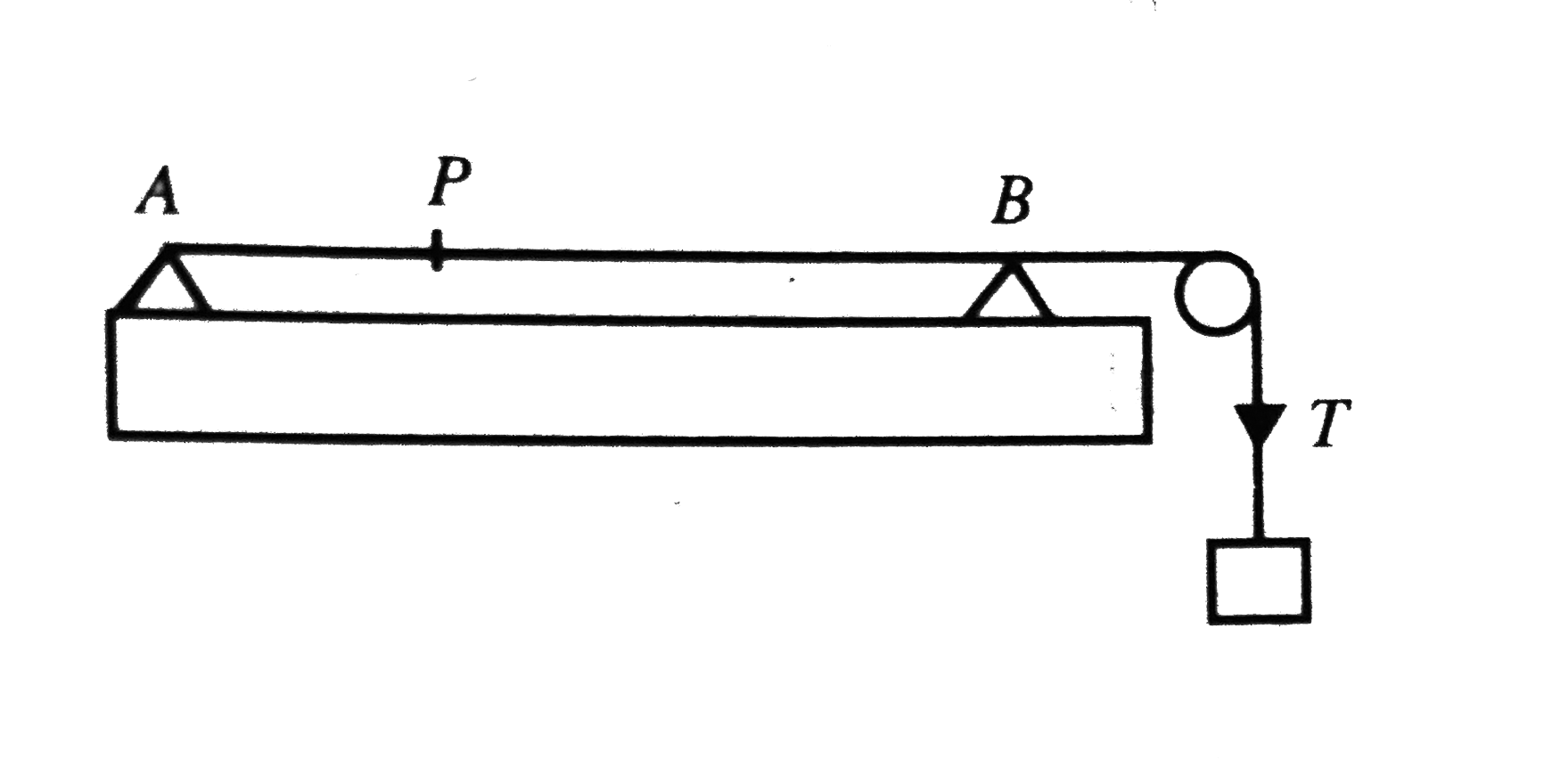A sonometer strings AB of length 1m is stretched by a load and the tension T is adjusted so that the string resonates to a frequency of 1kHz. Any point P of the wire may be held fixed by use of a movable bridge that can slide along the base of sonometer.

If point P is fixed so that AP:PB:1:4, then the smallest frequency for which the sonometer wire resonates is 5kHz.
If P be taken at midpoint of AB and fixed , then when the wire vibrates in the third harmonic of its fundamental , the number of nodes in the wire ( including AandB) will be totally seven.
If the fixed point P divides AB in the ratio 1:2, then the tension needed to make the string vibrate at 1kHz will be 3T. (neglecting the terminal effects)
The fundamental frequency of the sonometer wire when P divides AB in the ratio a:b will be the same as the fundamental frequency when P divides AB in the ratio b:a.
The correct Answer is:A, B, D
If P divides AB in ratio 1:4, then the fundamental frequency corresponds to 5 loops , one loop in AP and 4 loops in PB which corresponds to 5th harmonic of 1kHz. Hence fundamental =5kHz.
If P be taken at midpoint , the third harmonic will have three loops in each half of the wire AB. Hence total number of nodes (including A and B ) will be 5+2=7.
If P divides AB in the ratio 1:2, the fundamental will have three loops , corresponding to the frequency of 3kHz. For this string to vibrate with the fundamental of 1kHz , the tension must be (T/9).
The wire AB will be symmetry , vibrates with the same fundamental frequency when P divides AB in the ratio a:b or in the ratiob:a.
Topper's Solved these Questions
- SUPERPOSITION AND STANDING WAVESBook:CENGAGE PHYSICSChapter:SUPERPOSITION AND STANDING WAVESExercise:Assertion - Reasoning
Explore 6 Videos
- SUPERPOSITION AND STANDING WAVESBook:CENGAGE PHYSICSChapter:SUPERPOSITION AND STANDING WAVESExercise:Comprehension
Explore 55 Videos
- SUPERPOSITION AND STANDING WAVESBook:CENGAGE PHYSICSChapter:SUPERPOSITION AND STANDING WAVESExercise:Single Correct
Explore 144 Videos
- SOUND WAVES AND DOPPLER EFFECTBook:CENGAGE PHYSICSChapter:SOUND WAVES AND DOPPLER EFFECTExercise:Integer
Explore 16 Videos
- THERMODYNAMICSBook:CENGAGE PHYSICSChapter:THERMODYNAMICSExercise:24
Explore 1 Video
Similar Questions
A sonometer wire having a length of 1.50 m between the bridges vibrates in its second harmonic in resonance with a tuning fork of frequency 256 Hz. What is the speed of the transverse wave on the wire ?
View SolutionA sonometer wire of length 1 m is stretched by a weight of 10 kg. The fundamental frequency of vibration is 100 Hz. Determine the linear density of material of wire.
View Solution
Knowledge Check
If a sonometer wire of length 110 cm fixed horizontally under a constant tension, then the bridge be placed below the wire so that the two segments can emits note whose frequency are in the ratio 3:2, is
A44cm and 66 cmB66 cm and 44cmC25cm and 75cmD41.5 cm and 58.5 cmA sonometer wire of length 114 cm is fixed at both the ends. Where should the two bridges be placed so as to divide the wire into three segments whose fundamental frequencies are in the ratio 1:3:4?
AAt 36 cm and 84 cm from one endBAt 24 cm and 72 cm from one endCAt 48 cm and 96 cm from one endDAt 72 cm and 96 cm from one endTwo stretched strings have lengths 1 and 21 while tensions are T and 4 T respectively. If they are made of same material the ratio of their frequency is
A2:1B1:2C1:1D1:4
(i) A wire is stretched between two rigid supports. It is observed that the wire resonates at a frequency of 420 Hz. If a wooden bridge is placed at the midpoint of the wire (so that the midpoint becomes a node), it was observed that the smallest frequency at which the wire resonates is 420 Hz. Find the smallest frequency at which the wire will resonate when there is no wooden bridge.
(ii) A string of length L is fixed at one end and is under tension due to a weight hanging from the other end, as shown in the figure. The point of the string on the pulley behaves as a fixed point. Coordinate axes are chosen so that the horizontal segment of the string runs from x=–L/2 to x=L/2. The string is vibrating at one of its resonant frequencies with transverse displacement (y) given by
y(x,t)=0.05cos(12.0x)sin(360t)
with x, y in meter and t in second. Write two smallest possible values of L consistent with the given equation?

View SolutionA uniform string of length 6.5m is subjected to a tension of 40N. Mass of the string is 162.5g. One end of the string is fixed and the other end is tied to a source (s). which produces a transverse oscillation. The displacement of the end of the string tied to the source can be expressed as y=(3mm)sin(40πt), where ‘t’ is time. Find the displacement of point P of the string at a distance of 3.75m from the fixed end, at time t=0.3s.

View SolutionA sonometer wire has a total length of 1m between the fixed ends. Where should the two bridges be placed below the wire so that the three segments of the wire have their fundamental frequencies in the ratio 1 : 2 : 3 ?
View SolutionTwo srting of the same length, radius and material are stretched by η1=2% and η2=4% respectively.Find the ratio of frequency of the strings .The tension of the string may be assumed to be proportional to the elongation
View SolutionA knife edge divides a sonometer wire in two parts which differ in length by 2mm. The length of the wire is 1m. The two parts of the string when sounded together produce on beat per second, then the frequency of the smaller and the longer parts of the wire in Hz will be
View Solution